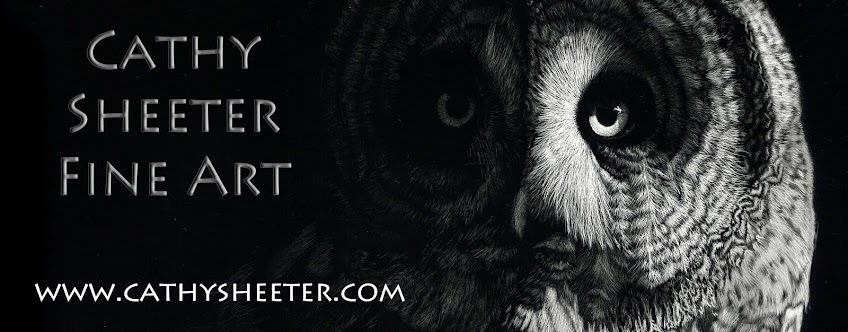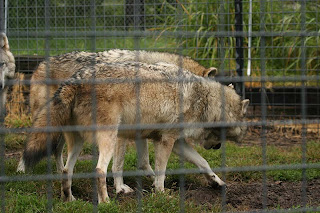I asked on facebook what people would like to see me discuss on this blog and the topic of tools was one that many people were interested in.
There are MANY tools that can be used on scratchboard, and your imagination is the limit. I have scratched with a bobbi pin, spoon, dremel bits, electric eraser, pencil eraser, heck... you could even use a screw! Anything that will remove the top layer of ink can be used :)
But I am going to touch on my primary tools that I keep in my tool box, both how to use them and where to get them.
LINE TOOLS
First we are going to talk about line tools. The vast majority of MY work is done with the line tools, which I have photographed above. I use them for fur, eyes, tongues, leather... well just about everything! The fiberglass brush is not really a line tool, but I will get into its use in a moment. The rest are used for... well lines :) You really can get a very long ways in scratchboard with just a standard #11 exacto and for a very long time it was the only tool I used. Older works of mine, such as "Dress Attire" were done all with an exacto. You can see that even with just this one tool I was able to do a lot of different textures and shading.
In more recent years I have added to my tools to give more diversity in line width. About two years ago I got turned onto speedball scratchboard tips #112 and 113, which are available from http://www.danielsmith.com/. These two tips produce wider lines than the exacto and are great for course fur and whiskers! Then about 10 months ago I started working with a scalpel which yields finer lines than the exacto. The blade is not as stiff as an exacto blade and required some getting used to. The diversity of line widths that can be produced with these four tools adds to the realism of my work since fur does vary in texture and coarseness, and realistically I rarely reach for my exacto anymore, mostly using the speedball and scalpel blades. Exacto blades can be purchased at any tool or craft store and scalpel blades at any medical center or veterinary supplies store (or many sources online as well).
Like all cutting tools, blades will get dull after some use. You can resharpen some of these tools, but others you will just need new ones. Since exacto and scalpel blades are pretty inexpensive I usually just replace them if dull. You can tell if a blade is dull if it requires a moderate amount of pressure to remove the ink or is skipping. For most of these tools only very light pressure should be needed to remove the ink.
SHADING TOOLS
As I said before you can get a long ways with just line tools, but there are certain effects that are tough to do all with lines. Fortunately, unlike pen and ink, we have some additional tools that yield some softer effects than just lines. The challenge with all of the shading tools is control, as they don't allow the finesse of the line tools. At times masking off finer scratched areas may be required.
Sandpaper/foam nail buffer can take off a light layer of ink, but leave a toning of dark underneath with a fairly soft look to it. Used in straight lines they yield a different feel and look than if used in a circular pattern. For both tools use fine grit, as the courses grits leave an uneven look and feel. Both of these will fill up with ink after a bit of use, so you will need to have multiple pieces on hand. You can usually rip or cut sandpaper and use scissors to cut the nail buffers into the size/shape you want. Sandpaper I purchase at hardware stores and nail buffers in the beauty supply section at the local grocery store.
Steel wool can be used for certain fur effects as well as shading. It comes in several coursenesses and I personally prefer to only use the fine and medium. Always make sure your steel wool does not have any oils or coatings on it. It can be purchased where ampersand products are sold or hardware stores.
Fiberglass brushes can come in a variety of sizes. I only use the very small and small sizes. You will also find that different brands have different hardnesses to their bristles. I primarily use a very small one that I buy from http://www.micromark.com/. This tool requires some practice to get down and the tiny bristles will break off and can embed in the side of your hand (ouch!) Gloves can help, but those bristles are so tiny they go through most fabrics as well.
Adding to the Supply Box
Another item to add to the supply box is black repair ink. I use it for ink washes to tone down areas that are too light or can be used in concentrate to totally get rid of something. I apply it with a small, inexpensive paint brush.
Here is a sample of the different thicknesses of lines from each tool. The furthest left is applied with minimal pressure (to yield the thinnest line I can) and the right is with heavier pressure (to give a thicker line from each tool). The dime is for size comparison.
And here is a close up on the mountain lion's legs with indication of what tools were used in each area... and some areas have more than one tool used in any specific area.
If you have additional tool questions please post them as a comment and I will try and address them.









































